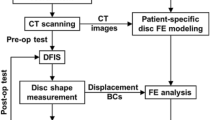Abstract
Introduction: We did not find any in vivo study of spinal segment kinematics after disc replacement, especially over the long term. In vitro studies did show that it restores almost normal kinematics except for axial rotation. The goal of this study is to develop a new technique in order to analyse axial rotation of a spinal segment, in vivo, after total disc replacement. Materials and methods: A comparative retrospective study of motion in axial rotation at L4L5 level was carried out on 17 patients with artificial discs versus six healthy volunteers. Five patients carried one prostheses at L4L5 level and 12 carried two prosthesis at L4L5 and L5S1 levels. The follow up ranged from 10.8 to 14.3 years (average 12.4±1, median 12.6). Dynamic radiographs in axial rotation were made using a special protocol. A new technique associating a stereographic method and image processing software was developed in order to evaluate the range of motion in axial rotation as well as the mechanical coupling. Results: The standard deviation of angular measurements was 1.8°. Eleven (65%) patients had a normal mobility in torsion, identical to those of the volunteers and of the literature, whereas six (35%) had an abnormal increased mobility. If only one disc was replaced, mobility in torsion was identical to that of the volunteers, in the case of two replaced discs, 50% (6/12) of the patients had an abnormal increased mobility. In the sub-group of normal mobility, the coupling was identical to that of the volunteers. In the sub-group of increased mobility, the coupling was different with a strong flexion (10°), increased by about 7° (P<0.001). Conclusion: The implementation of only one discal prosthesis SB Charité seems to restore kinematics close to that of the healthy volunteers and comparable to the literature. The implementation of two adjacent prostheses does not restore normal kinematics in 50% of the cases. It is probable that the existence of active stabilizing elements explains the difference with the in vitro studies carried out beforehand.


















Similar content being viewed by others
References
Bogduk N (1983) The innervation of the lumbar spine. Spine 8:286–293
Bogduk N, Pearcy M, Hadfield G (1992) Anatomy and biomechanics of psoas major. Clin Biomech 7:109–119
Dumas R, Mitton D, Laporte S, Dubousset J, Steib JP, Lavaste F, Skalli W (2003) Explicit calibration method and specific device designed for stereoradiography. J Biomech 36:827–834
Fujiwara A, Lim T, An H, Tanaka N, Jeon C, Andersson G, Haughton V (2000) The effect of disc degeneration and facet joint osteoarthritis on the segmental flexibility of the lumbar spine. Spine 25(23):3036–3044
Graf H (1992) Instabilité vertébrale: traitement à l’aide d’un système souple. Rachis 4:123–137
Gracovetsky S (1988) The spinal engine. Springer-Verlag, Wien-NY
Gregerson G, Lucas DB (1967) An in vivo study of axial rotation of the human thoracolumbar spine. J Bone Joint Surg 49A:247–262
Groen GJ, Baljet B, Drukker J (1990) Nerves and nerve plexuses of the human vertebral column. Am J Anat 188:282–296
Haughton VM, Rogers B, Meyerand ME, Resnick DK (2002) Measuring the axial rotation of lumbar vertebrae in vivo with MR imaging. Am J Neuroradiol 23:1110–1116
Husson JL (1995) Instabilité vertébrale à l’étage lombaire. Conférences d’enseignement de la Sofcot 52:63–78
Jackson HC, Winkelmann RK, Bickel WH (1966) Nerve endings in the human lumbar spinal column and related structures. J Bone Joint Surg 48A:1272–1281
Link HD (2002) History, design and biomechanics of the link SB charite artificial disc. Eur Spine J Suppl 2:S98–S105
Louis R (1982) Chirurgie du rachis: anatomie chirurgicale et voies d’abord. Springer-verlag, Berlin
Panjabi M, Abumi K, Duranceau J, Oxland T (1989) Spinal stability and intersegmental muscle forces. A biomechanical model. Spine 14(2):194–200
Pearcy MJ, Tibrewal SB (1984) Axial rotation and lateral bending in the normal lumbar spine measured by three-dimensional radiography. Spine 9(6):582–587
Pearcy MJ, Hindle RJ (1991) Axial rotation of lumbar intervertebral joints in forward flexion. Proc Instn Mech Engrs 205:205–209
Pearcy MJ (1993) Twisting mobility of the human back in flexed postures. Spine 18(1):114–119
Penning L (2000) Psoas muscle and lumbar spine stability: a concept uniting existing controversies. Critical review and and hypothesis. Eur Spine J 9:577–585
Penning L (2002) Spine stabilization by psoas muscle during walking and running. Eur Spine J 11:89–90
Plamandon A, Gagnon M, Maurais G (1988) Application of a stereoradiographic. Methode for the study of intervertebral motion. Spine 13(9):1027–1032
Rabischong P, Louis R, Vignaud J, Massare C (1979) Le disque intervertébral. Anat Clin 1:55–64
Rogers B, Haughton VM, Arfanakis K (2002) Application of image registration to measurement of intervertebral rotation in the lumbar spine. Magn Reson Med 48:1072–1075
Santaguida PL, Mc Gill SM (1995) The psoas major muscle. J Biomech 28:339–345
Skalli W, Lavaste F, Descrimes JL (1995) Quantification of three-dimensional vertebral rotations in scoliosis: what are the true values? Spine 20(5):546–553
Stokes I, Bigalow LC, Moreland MS (1986) Measurement of axial rotation of vertebrae in scoliosis. Spine 11(3):213–217
Templier A, Skalli W, Lemaire JP, Diop A, Lavaste F (1999) Three-dimensional finite-element modelling and improvement of a bispherical intervertebral disc prosthesis. Eur J Orthop Surg Traumatol 9:51–58
Wilke HJ, Wolf S, Claes LE, Arand M, Wiesend A (1996) Influence of varying muscle forces on lumbar intradiscal pressure: an in vitro study. J Biomech 29(4):549–555
White AA, Panjabi M (1978) The basic kinematics of the human spine. A review of past and current knowledge. Spine 3:12–20
Author information
Authors and Affiliations
Corresponding author
Rights and permissions
About this article
Cite this article
SariAli, Eh., Lemaire, J.P., Pascal-Mousselard, H. et al. In vivo study of the kinematics in axial rotation of the lumbar spine after total intervertebral disc replacement: long-term results: a 10–14 years follow up evaluation. Eur Spine J 15, 1501–1510 (2006). https://doi.org/10.1007/s00586-005-0016-5
Received:
Revised:
Accepted:
Published:
Issue Date:
DOI: https://doi.org/10.1007/s00586-005-0016-5




